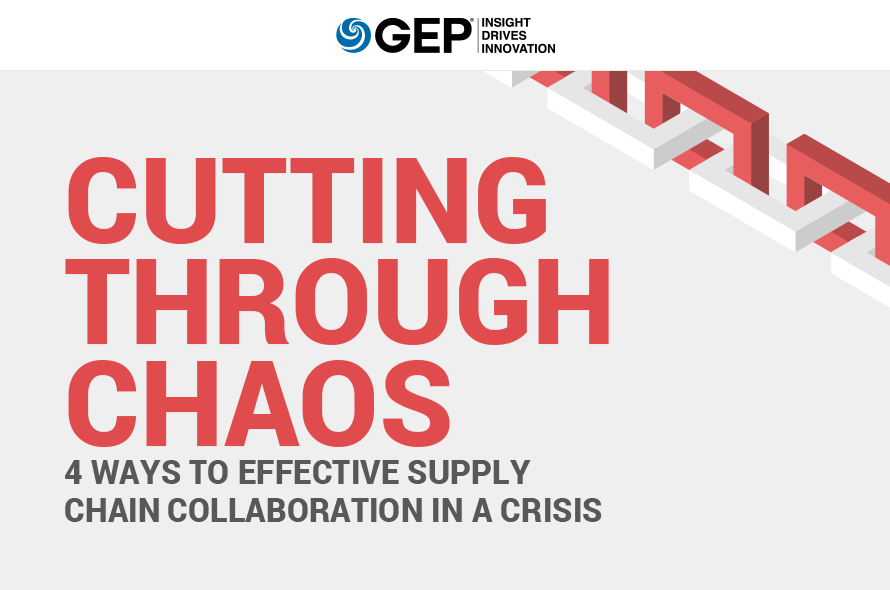Amid the COVID-19 pandemic, supply chain leaders have a lot of uncertainty to manage.
Where should you start? By proactively working with your supply base, customers, strategic partners and third parties.
Easier said than done.
Our latest GEP BULLETIN, Cutting Through Chaos: 4 Ways to Effective Supply Chain Collaboration in a Crisis, offers specific guidance on the most effective strategies and technologies for managing gaps across inventory and networked supplier partners.
What’s Inside:
- Why real-time visibility matters
- Why networkwide information sharing is crucial
- How scenario planning is more important than ever
This paper is a must-read for all supply chain leaders who need to take charge and ensure positive business outcomes.
REAL-TIME VISIBILITY AND COLLABORATION ARE PARAMOUNT
Pandemics, natural disasters, wars, acts of terrorism and other crises create significant disruptions to our interconnected global supply chains. Currently, the COVID-19 outbreak is affecting global supply chains like we have never seen before. The worst may be yet to come as the disruption to manufacturing and other business operations around the world increases daily.
Very few organizations are immune, and revenues have been all but fully wound down in some industries. Plant closures, layoffs, cash flow, debt challenges and export issues highlight some pain points. Supply chain organizations must step up now and take equal positive action with their supplier partners as these negative events unfold.
Here are key strategies that supply chain leaders can use to bolster and protect their business and operation with a keen focus on collaborative internal and external efforts.
ANALYZE & PRIORITIZE
Time is of the essence and rapid response is needed. However, that response should be well-thought-out and prioritized so that it can be executed efficiently to bring the most value. Ask yourself these questions:
- Do you already have a crisis response plan?
- What systems are in place right now — internally or externally — that can provide the data and information required to assess everything?
- Where are the critical gaps in: Supply, costs, working capital, supplier details, customer details, inventory information, transportation and logistics data, and relevant market intelligence?
- Who are the key supply chain partners you can leverage through this crisis?
You need all available hands on deck.
SHARE INFORMATION AND GET VISIBILITY INTO TRADING PARTNER NETWORKS
There is little business immunity to COVID-19 in your trading partner network. Now is the time to share all relevant and available information with each other to bring value to the entire network. A combined team effort can have an exponential positive impact — and the nature of many interconnected global supply chains demands it.
Your supply base, customers, strategic partners and third-party providers all might feel similar pain but could unintentionally create an action plan that is counter-productive to your business needs. Take the lead and communicate across this network early and often.
You cannot do it alone.
NETWORKWIDE COLLABORATION
Once you’ve started sharing information with trading partners you can then activate a networkwide collaboration plan with every key priority in the following areas:
- Relevant order information
- Forecasts
- Inventory status
- Transportation and logistics data
- Any and all applicable supply chain information required for the network to keep them up-to-date and take action
Have a communication and information management structure in place so that key prioritized business actions can be executed in a collaborative environment.
You need your action plan to be fully aligned with partners.
SCENARIO PLANNING AND POSITIVE ACTIONS
Use the digital platforms you and your strategic partners have in place for scenario planning of key priorities and actions. These can and should be from an operational (continuity of supply), cost (savings), and cash flow perspective. ERP systems, supply chain control tower software and other digital platforms can be critical to providing real-time visibility into your network — and for game-planning positive business outcomes. Use all of the information available in these digital systems, trading partner systems, and offline systems (such as spreadsheets, inherent business knowledge) to drive the best decision-making.
Key focus areas include:
- Primary and secondary sources of direct and indirect materials
- Primary and secondary sources of transportation/logistics carriers and routes
- Inventory positions and locations
- Payment terms and cycle
- Cash flow and working capital positions
- Credit positions
- Payment postponement opportunities
- Order cancellation opportunities
- Rapid sourcing opportunities
- Planning and prioritized execution
You need real-time intelligence and a single version of the truth.
RAPID RESPONSE SOLUTIONS FROM GEP
As the coronavirus crisis intensifies, managing your supply chain is going to get even more challenging. It may be worth finding a partner with deep experience in procurement and supply chain management to reinforce your capabilities and help you stay on course.
If you would like to have a conversation about how we can help, please reach out to our supply chain leadership.

James King
Senior Director, Consulting GEP
James has 25 years of global supply chain and procurement experience in both consulting and executive-level leadership positions in large organizations. At GEP, he is responsible for leading large-scale supply chain transformation projects across a variety of industries.

